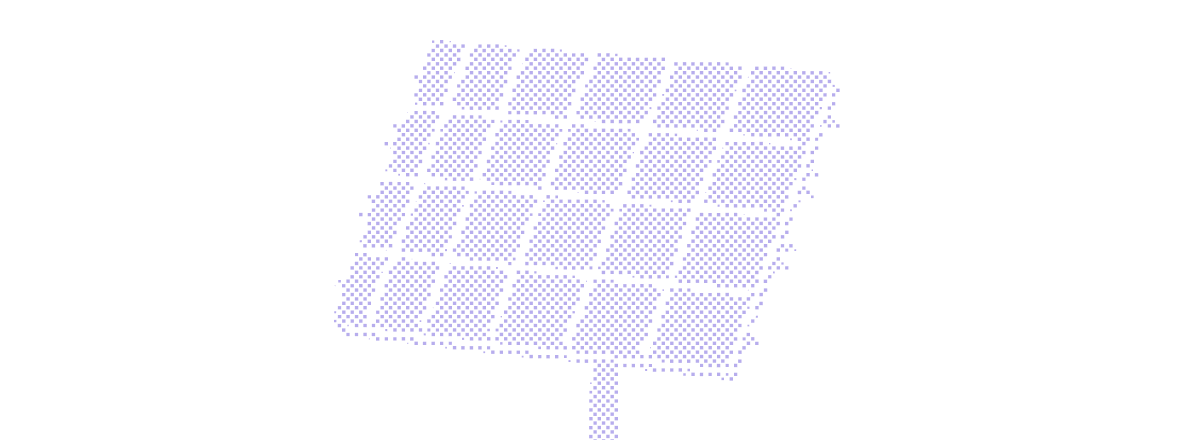Critical BESS design principles: AC vs. DC coupling explained
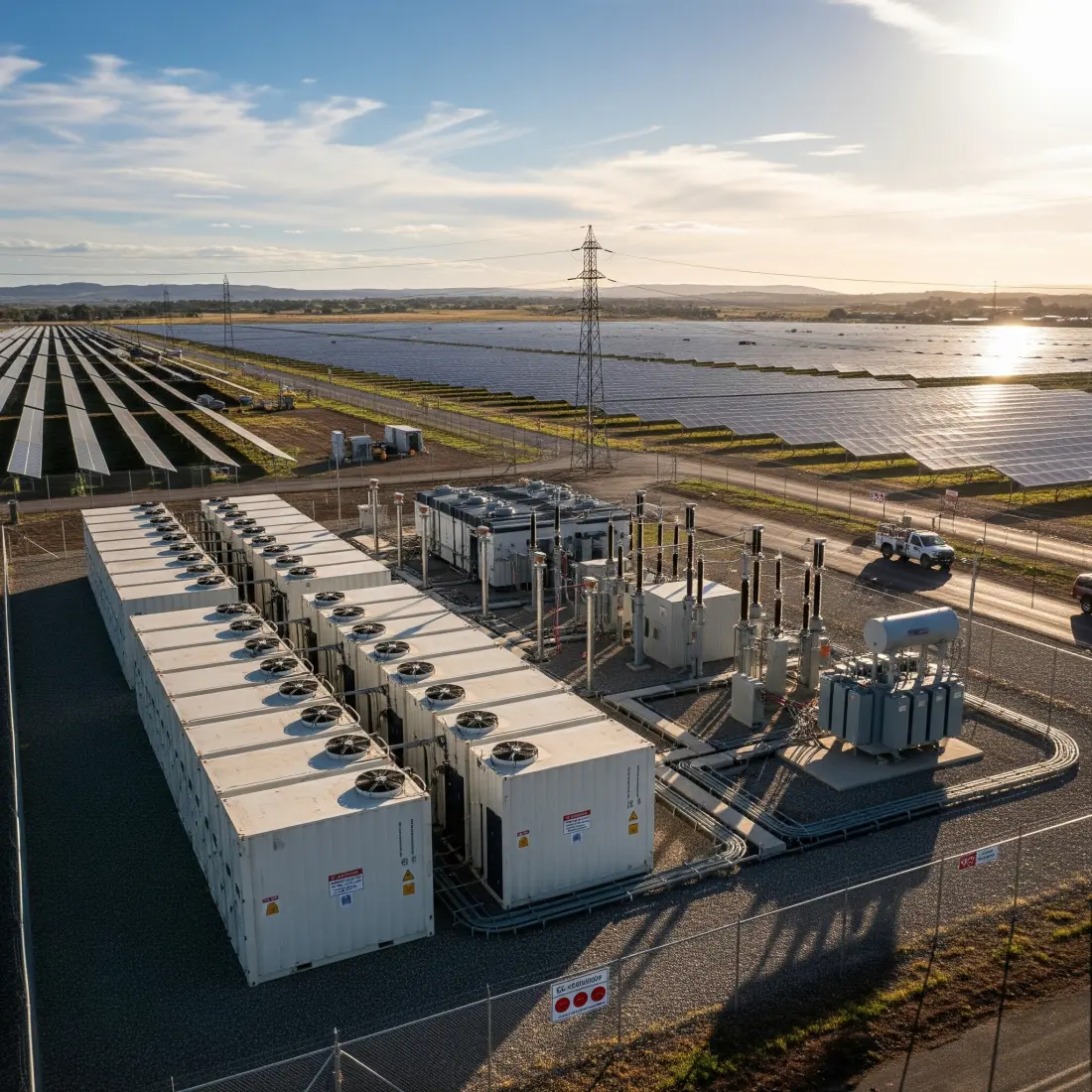

Modern solar power plants are rapidly evolving. The growing need for grid stability and renewable energy integration has made battery energy storage systems (BESS) indispensable.
These systems help solar installations provide reliable power through "firming capacity," ensuring consistent output even when the sun isn't shining. They also contribute to "peak shaving" by reducing grid demand during high electricity use, and "energy shifting," storing excess solar energy for later.
However, integrating BESS into a solar plant design — or co-locating — is more than a simple plug-and-play process. Developers face many challenges, from selecting components and managing energy flows to dealing with further permitting and regulations. Additionally, ensuring seamless communication between systems, such as the Battery Management System (BMS) and plant controls, is vital.
Not less important is choosing between AC-coupled and DC-coupled BESS architectures, each with its own set of advantages and disadvantages that significantly impact project performance and cost. This is where advanced design software becomes crucial. Aiming to simplify solar project development, PVcase now offers new features that streamline BESS integration, making it easier than ever to incorporate both types of coupling of this crucial infrastructure.
Understanding BESS coupling: AC vs. DC
BESS coupling describes how a battery energy storage system connects to the electrical architecture of a power plant or similar facility. In the case of a solar power plant, it determines the flow of electricity between the battery, solar array, and grid. The two main methods are AC-coupled BESS and DC-coupled BESS, each with distinct advantages and disadvantages.
AC-coupled BESS explained
AC coupling connects the BESS to the alternating current (AC) side of the solar power system. Both the solar array and the battery energy storage system use their own inverters to convert direct current (DC) electricity to AC.
Solar panels generate DC power, converted to AC by the solar inverter. This AC power can go to the grid or an AC bus. For storage, it moves from the AC bus to the BESS inverter, converting it back to DC for battery charging. When stored energy is needed, the BESS inverter converts it back to AC for facility use or export.
Advantages of AC-coupled BESS
✅ Flexibility for retrofitting: AC coupling offers notable flexibility, especially for retrofitting existing solar plants. Because solar and BESS operate independently on the AC side, adding storage to an operational solar farm is often simpler.
✅ Easier inverter integration: This setup allows for easier integration of different inverter types from various manufacturers.
✅ Modular expansion: Modular expansion is straightforward; users can add more solar or more storage capacity independently as needs change.
✅ Simplified DC wiring: Lower voltage DC wiring from the battery to its inverter can simplify electrical aspects.
✅ Clearer metering: Metering solar versus storage is clearer as each has a separate inverter.
Disadvantages of AC-coupled BESS
❌ Efficiency losses: Multiple power conversions lead to efficiency losses, typically between 5% and 10%.
❌ Higher equipment costs: AC-coupled systems generally have higher equipment costs due to requiring separate inverters for solar and BESS, effectively doubling inverter hardware.
Use Cases of AC-coupled BESS
AC coupling is often preferred for adding battery energy storage to existing solar plants. It suits projects focused on energy shifting or providing grid services that do not rely on direct DC charging from the solar array.
DC-coupled BESS explained
DC coupling integrates the BESS on the direct current (DC) side of the solar power system, usually sharing a common DC bus with the solar array.
DC power from the solar array flows directly to a shared DC bus, where the storage system also connects. A single "hybrid inverter/charger" converts the combined DC power from solar and/or batteries into AC power for the grid or facility.
Advantages of DC-coupled BESS
✅ Higher efficiency: A significant benefit is fewer power conversions. Electricity can flow directly from solar panels to batteries as DC, or from panels to the inverter, resulting in lower round-trip losses. This often leads to overall system efficiency gains and optimized self-consumption.
✅ Lower equipment costs: Equipment costs are generally lower, as often only one hybrid inverter is needed instead of two separate ones.
✅ Better low-light charging: DC-coupled systems can perform better in low-light conditions for battery charging.
✅ Simpler control systems: Their control systems can be simpler, as a single device manages power flow, reducing coordination complexity.
Disadvantages of DC-Coupled BESS
❌ Less flexible for retrofits: DC coupling offers less flexibility for retrofitting existing AC-coupled solar plants due to significant re-wiring and potential inverter replacement.
❌ More complex wiring/design: The DC wiring and overall system design can be more complex due to higher voltages and currents on the shared DC bus.
❌ Challenges with scaling/integration: Scaling or integrating different types of DC sources or augmenting existing BESS can present challenges, requiring careful planning for voltage compatibility and control.
❌ DC bus voltage limitation: The system's design can be limited by the common DC bus voltage, requiring all components to be compatible.
Use Cases of DC-Coupled BESS
DC coupling is typically preferred for new solar-plus-storage installations designed from the ground up. It's ideal for projects focused on maximizing round-trip efficiency, reducing overall equipment costs, and optimizing direct energy storage. It is also well-suited for projects requiring specific grid services that benefit from tight integration between solar generation and battery dispatch.
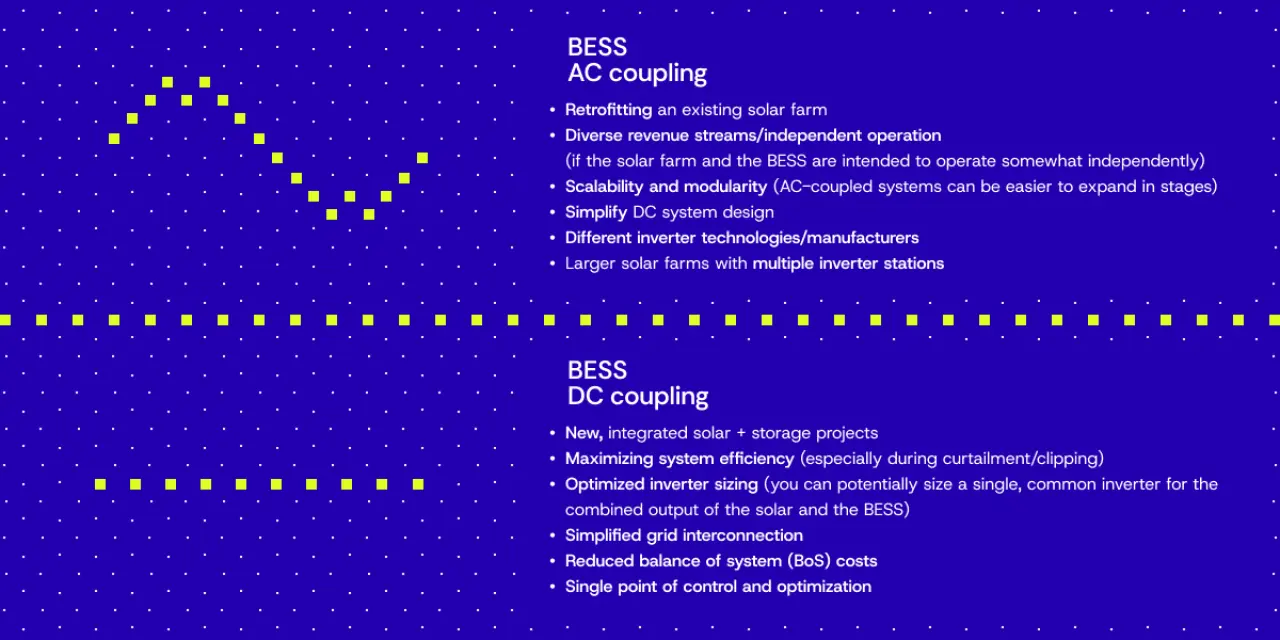
Choosing the right coupling method for your project
Beyond the technical differences between AC and DC coupling, the ultimate decision for a solar-plus-storage project depends on practical considerations. These factors dictate the best performance, economic viability, and long-term success for your specific application.
Key considerations
When designing a battery energy storage system, project developers and engineers must weigh several critical points:
⚡ New build vs. retrofit: DC coupling often offers efficiency and cost benefits for new installations. For retrofitting existing solar plants, AC coupling is typically simpler and more cost-effective.
⚡ Project size and scale: Larger utility-scale projects may have specific redundancy, grid service, and loss management needs. Smaller commercial or industrial projects might prioritize simplicity and lower upfront costs.
⚡ Desired system efficiency: For projects prioritizing maximum energy storage round-trip efficiency, DC coupling often holds an advantage due to fewer power conversions.
⚡ Budget constraints: The initial capital expenditure is always a major concern. AC-coupled systems, requiring two separate inverters, can have higher equipment costs. DC-coupled systems, using a single hybrid inverter, may be more budget-friendly for new builds.
⚡ Specific grid service requirements: Different grid services (e.g., frequency regulation, voltage support) may favor one coupling method over another, especially those requiring rapid response times.
⚡ Site constraints: Physical space for equipment is important. DC-coupled systems, with fewer separate components, can sometimes require less overall space. Environmental conditions at the site, such as extreme temperatures or high humidity, also influence component selection and layout.
⚡ Battery chemistry and technology: The chosen battery chemistry (e.g., lithium-ion) and its specific voltage or charging requirements can subtly favor one coupling method. Some battery technologies integrate more seamlessly with a direct DC connection.
⚡ Future expansion plans: Consider how easily the system can be expanded (e.g., adding more PV, more storage). AC coupling often offers greater modularity for future additions without complete re-engineering.
⚡ Regulatory environment: Local codes, utility interconnection rules, and incentives (e.g., tax credits for co-located systems) can all play a role. Certain regions or programs might implicitly encourage or penalize one coupling method through their regulations.
⚡ Operational goals: The core purpose of the BESS is crucial. Whether the goal is energy arbitrage, demand charge management, resilience/backup, or maximizing self-consumption of solar energy, each can subtly favor a different coupling approach.
⚡ Reliability and redundancy needs: AC-coupled systems, with their separate inverters, can offer greater redundancy. If one inverter fails, the other part of the system can often still operate, maintaining some power generation or storage.
PVcase Ground Mount: revolutionizing BESS integration
Beyond the trade-offs of AC and DC BESS coupling, having the right tools for efficient and accurate design is essential. Renewable energy developers and electrical engineers face particularly complex challenges when it comes to hybrid solar systems. These often involve time-consuming manual calculations, potential errors, and difficulty visualizing integrated systems.
PVcase Ground Mount directly addresses many of these pain points, offering powerful features for both AC-coupled BESS and DC-coupled BESS integration.
PVcase Ground Mount's AC-coupled BESS features
PVcase Ground Mount allows seamless incorporation of AC-coupled BESS directly into electrical designs. This capability enables accurate project planning and efficient development by facilitating integrated BESS design and support analysis of hybrid system efficiency.
This translates into several key benefits for projects:
🎯 Improved design flexibility: Designs can be adapted to various project requirements, whether for new installations or retrofitting existing solar plants.
🎯 Accurate project planning: Precise data and calculations directly within the software lead to more reliable project forecasts and budgeting.
🎯 Streamlined workflow: By integrating BESS design into the familiar PVcase Ground Mount environment, the need for separate tools and manual processes is eliminated, saving significant time.
Thus, placing BESS components, generating all necessary AC cabling, and accurately calculating voltage drops and material quantities is simplified. Furthermore, the software automatically updates device overviews, Bills of Materials (BOMs), and Single Line Diagrams (SLDs) to reflect the complete hybrid system, providing clear and consistent documentation.
This automated approach drastically reduces design hours, minimizes human error, and provides more reliable cost estimations early in the project lifecycle. It also facilitates scaling designs, such as replicating BESS configurations across a large site.
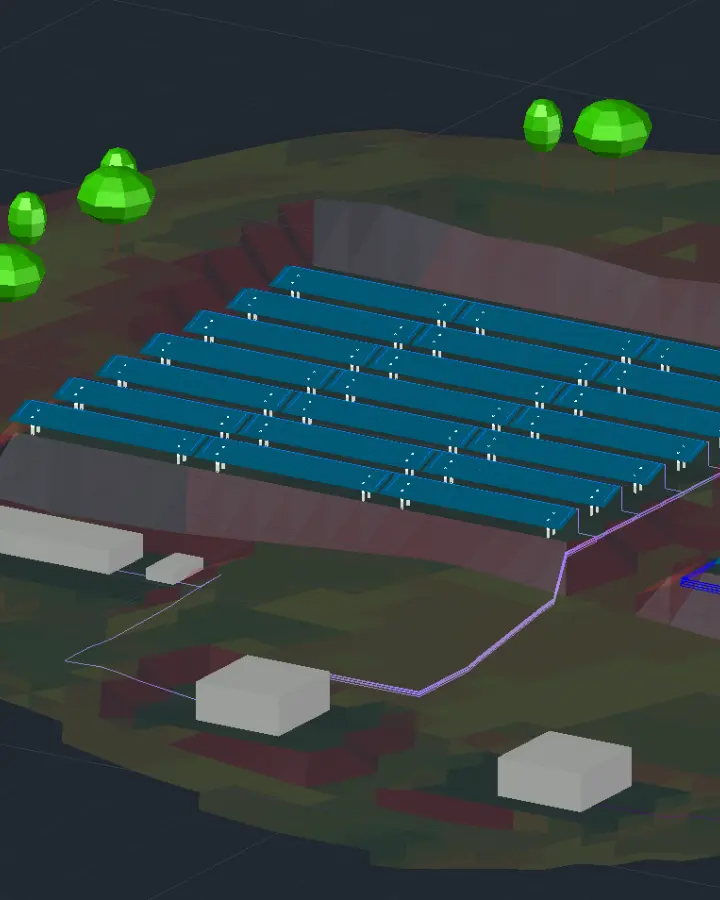
PVcase Ground Mount's DC-coupled BESS features
PVcase Ground Mount now also supports integration of DC-coupled BESS directly into electrical designs. This allows users to generate accurate and comprehensive deliverables for their DC-coupled projects.
The benefits of this feature include:
🎯 Expanded design capabilities: Users gain the ability to design highly efficient DC-coupled systems, opening new project possibilities.
🎯 Streamlined workflow: Integrated tools reduce manual effort and accelerate the design process for complex DC configurations.
🎯 Accurate documentation: All project details, from cabling to component lists, are precisely documented, ensuring consistency.
🎯 Increased project scope: Users can confidently undertake more sophisticated and optimized hybrid projects, leveraging the advantages of DC coupling for higher efficiency and potentially lower costs.
Powering the future of solar-plus-storage design
Choosing between AC and DC coupling for energy storage is a fundamental decision that shapes a solar project's performance, cost, and long-term viability. As explored, each method offers distinct advantages and drawbacks, making the "best" choice highly dependent on project-specific goals, existing infrastructure, and future aspirations.
Regardless of the chosen coupling method, effective and intuitive design tools are paramount. PVcase Ground Mount provides solar professionals with the capabilities to accurately design, optimize, and document complex hybrid solar power plants. By integrating both AC-coupled BESS and DC-coupled BESS features, it helps users overcome design challenges, streamline their workflow, and ultimately deliver more efficient, cost-effective, and successful renewable energy solutions.
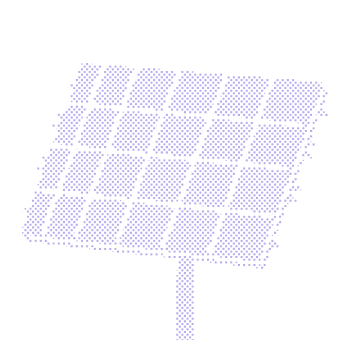

Leverage latest and greatest solutions to maximize your ROI
Book a demo and discover how PVcase can streamline your hybrid solar project on every step of its lifecycle.

